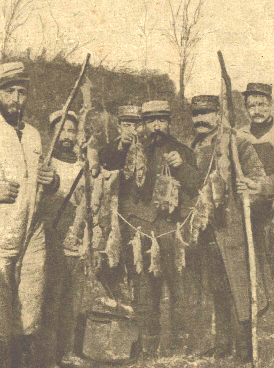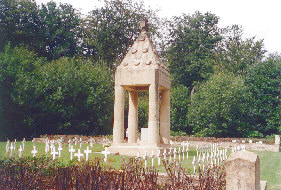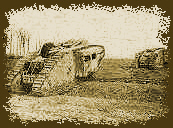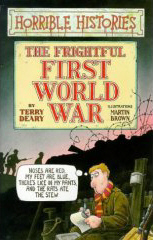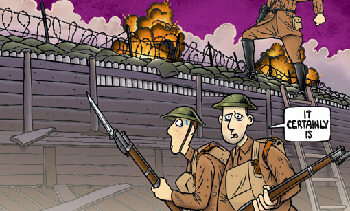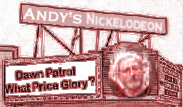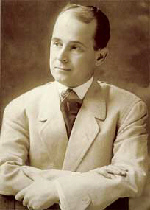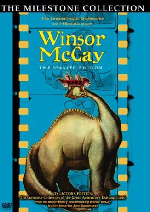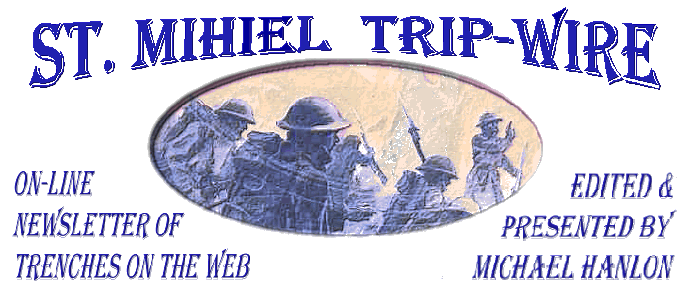
September 2006 |
Access Archives |
|
TRENCH REPORT: Welcome to our first issue from our new platform at Trenches on the Web. I've been asked two questions the past month. First, "Will the Trip-Wire stop covering the Great War Society?" Answer: No. We will continue to have full coverage and linkage to GWS sites. That said, I plan to continue similar coverage of the WFA and conduct more outreach to readers and contributors from other WWI organizations like the Gallipolians, Eastern Fronters, Aviation Historians, Churchillians, etc. Second, can we provide a downloadable pdf version of the Trip-Wire? Answer: Yes possibly, but I would have to charge a fee for the users of this extra service [say $5/mos] and I feel I would need at least 30 subscribers to make the commitment of time worthwhile. Email me if this is of interest (email). . .I hope you will also send a recommendation to your fellow history buffs, enthusiasts, researchers, battlefield explorers to take a look at the Trip-Wire. Also, you might have noticed that I always try to include something for younger people. My impression is that they are starved for information, especially in America, for interesting information on their heritage. Please think of sharing the Trip-Wire with them. .By the way, Anzac Biscuits [Simply the best oatmeal cookie ever invented for dunking in coffee] are now available by mail order from the Vermont Country Store. Four percent of sales are donated to the VFW. (link)
MH Alsace Forgotten Sector
|

Uniform of BG Billy Mitchell |
||||||||||||||||
GREAT WAR 2006 EVENT CALENDAR | |
|
90th Commemorative Events Comprehensive Double Calendar Scheduled Throughout 2006 (link) | |
|
Cleveland Gray's Armory October 21st (link) | |
|
UCLA, October 12-14, 2006 Los Angeles, CA (email for details) | |
|
Hartford, Connecticut November 11th (Program) | |
|
Great War Poster Artists and Luncheons With our Friends Jean- Pierre & Cecile Mouraux Sonoma, California, November 11th (details) | |
|
Email Response |
|
|
Speakers Bureau: Three of our favorite World War I Authors are going to be out on autograph/speaking tours in the next few months:
- Stephen Harris, Duffy's War, [Interview Below] New York State Military Museum,
Saratoga Springs, NY; Sat, Oct 14, Noon
- Tom Phelan, The Canal Bridge,
Full Schedule on Website (link) - Jacqueline Winspear, The Messenger of Truth,
14 City Tour (link)
There is also a computer flight simulator game now available (free demo)
Just received an announcement for a conference on military aerial photography and archaeology in Ypres at the Flanders Fields Museum, 19-21 October. (link-pdf file)

It becomes ever more obvious that the First World War was the great trauma of modern civilization. Something huge cracked in the First World War and has never been repaired. Out of the First World War came a series of rebellions against liberal civilization. These rebellions were accusations that liberal civilization was not just hypocritical or flawed, but was in fact the single great source of evil or suffering in the world. . .Behind all the movements that made these proposals was a pathological fascination with mass death. Mass death was itself the principal fact of the First World War, in which 9 or 10 million people were killed on an industrial basis. And each of the new movements proceeded to reproduce that event in the name of their utopian opposition to the complexities and uncertainties of liberal civilization. The names of these movements varied and the traits that they displayed varied -- one was called Bolshevism, and another was called fascism, another was called Nazism. . .My argument is that Islamism and a certain kind of pan-Arabism in the Arab and Muslim worlds are really further branches of the same impulse.
Paul Bergman, 2003 Interview

Propeller Driven Snow Sled: Apparently Eastern Front
We Welcome Any Information On Its Operational Service (email)
Click Here for News on Travel Opportunities |
Allen Dulles in the First World Warby Mark Murphy |
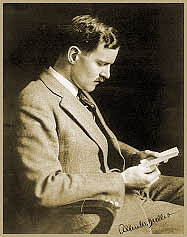 Dulles During the War |
When Dulles arrived at the legation, no one knew what to do with the extra help, so the first secretary took him aside and said, "I guess the best thing for you to do is take charge of intelligence. Keep your ears open. This place is swarming with spies. And write me a weekly report."
Dulles was elated. "I cannot tell you much about what I do," he wrote his father that night, "except that it has to do with intelligence."
Two Painful Lessons
Switzerland was swarming with spies-British, French, Italian, German, and Austro-Hungarian. In addition, Czech, Slovak, Slav, and Croat exiles were scheming and plotting to return home as soon as the Austro-Hungarian Empire collapsed. And then there were all the German and Russian emigres waiting for the war to end.In the midst of such intrigue, it took Dulles less than a week to flout one of the oldest rules of intelligence. He was at the office late one afternoon, finishing up as duty officer and looking forward to a tennis date, when the telephone rang. A man with a heavy German accent introduced himself as Vladimir Ilich Lenin and urgently requested a meeting for that same afternoon. Dulles assumed the caller was just another emotionally unstable emigre trying to get back to his homeland, looking for some sort of help. Dulles told him to stop by the next morning. "Tomorrow will be too late," Lenin replied impatiently, "I must talk to someone this afternoon." Dulles, however, was unyielding.
 Lenin, the Revolutionary |
Dulles later remarked that, following that episode, he decided he would see "all kinds of queer people, with and without beards." As DCI, he would often entertain new recruits with the story.
During his first few months in Switzerland, Dulles also learned something about the harsh realities of espionage. He had been dating a young Czech woman, only to learn from British intelligence that the Austrians had blackmailed her into spying. Because of the information she provided, at least two Czech agents had been executed, and an important British source had been compromised. Dulles, following a British plan, took her out to dinner and then strolled into the old section of town, where two British officers were waiting to take her away.
Dulles later remarked, "I never heard what happened to her. I learned that anyone can be blackmailed. And it is often the most patriotic citizen who is turned into a traitor."
Following the surrender of German troops in November 1918, Dulles was assigned to the Boundary Commission at Versailles, where he went to work on the newly created nation of Czechoslovakia.
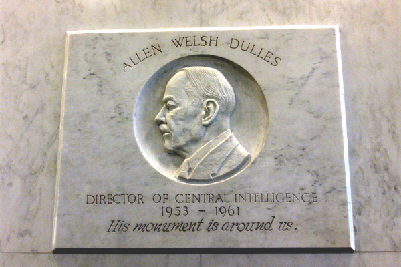
Monument at CIA Headquarters
|
Verdun |
 |
The Somme | |
Tavannes railway tunnel stretched from the battlefront to the French rear
areas and was reached by a narrow cutting. This gave cover to the French troops
approaching the front line, a degree of cover to the staff, storage for vast amounts
of ammunition, and even a space to lie down.
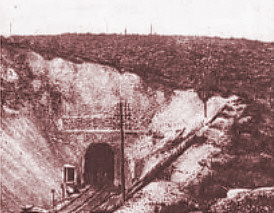 Tunnel EntranceBut on September 4th the ammunition in the tunnel blew up and the fire burnt for days. The French suffered a disaster similar to the German troops occupying Fort Douaumont in May earlier in the year. Officially 500 men died. In practice nobody knows the death toll. Click Here to See a Large
|
Tanks! Haig had a problem.
Click Here to See a Large
|
|
Somme-August continued:
Both at Verdun and on the Somme they immediately ordered that the policy of counterattacking cease and although all German held ground was to be properly fought for if lost, a defence line should be constructed to the rear of that place instead.  In the Mud at the SommeOn the Somme it began to rain. |
|

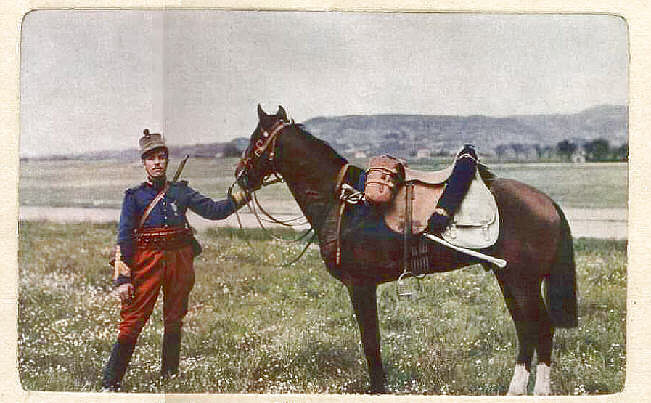
French Cavalryman Just Before the Battle of the Marne
|
in the 21st Century |
|
||||||||

|
The German Army on the Somme, 1914-1916Editor of Len's Bookshelf |
First published in 2005, this is a new look at one of The Great War's bloodiest campaigns, actually 12 battles extending over nearly five months from July to November 1916 and blending almost seamlessly into the ensuing Battle of the Ancre. More ink has probably been spilled in English on the Somme than on any other single campaign on the Western Front of 1914 to 1918. This time, however, the author examines the battles from the German point of view, drawing on surviving German archives and accounts. Each chapter is accompanied by detailed maps pinpointing the positions of the German units and participants whose recollections are quoted. This is a well-crafted monograph written by a former serving German-speaking officer, and based on solid scholarship.
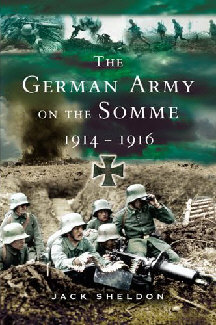 |
In all, the author sees the Somme battles as the beginning of the end of the German army in the West. German dead and wounded on the defensive nearly equaled those of the attacking BEF. The German high command can be faulted for maintaining an inflexible defense and for mounting repeated, costly and often unavailing counterattacks. Less able than the British to replace heavy casualties or train new recruits to the high standards of 1914 battleworthiness, Germany was after the Somme forced more and more to rely on desperate expedients such as unrestricted submarine warfare which simply contributed to ultimate defeat. On the other side, the BEF used the lessons of the Somme to improve its tactics and achieve in 1917 virtual parity with its adversaries and in 1918 victory in successive battles of attrition.
The German Army on the Somme, 1914-1916, Jack Sheldon, Pen & Sword 2006, maps, appendices, bibliography, notes index, 432 pages, ISBN 1 84415 269 3, $31.50 cloth.
Visit Len's Bookshelf for the Web's Largest List of WWI Books, Classics and New (link)
McCay was born on September 26, 1867. Accounts vary as to whether he was born in Canada or in Michigan. In any case, he grew up in Michigan and attended business school in Ypsilanti as teenager. During this time he took private art lessons from Professor John Goodison of Michigan State Normal (now Eastern Michigan University) and worked as a portrait artist in a dime museum. He worked in Chicago designing circus posters and then moved to Cincinnati where found work as a poster painter/publicist for the Vine Street Dime Museum, a permanent freak show in the city. He married fourteen-year-old Maude Leonore Dufour (1878-1949). Their son Robert was born in 1896 and their daughter Marion was born in 1897. In Cincinnati McCay was employed as an illustrator on the Commercial Tribune newspaper and the Cincinnati Enquirer where he in 1903 collaborated with George Randolph Chester (1969-1924) on creating a prototype comic page, A Tale of the Jungle Imps by Felix Fiddle. Some of these early strips have recently been found and are in the collection of Ohio State University. He was then hired by the New York Herald where he worked on several comic strips before creating Little Sammy Sneeze and Dream of the Rarebit Fiend in 1904. His masterpiece, Little Nemo in Slumberland first appeared in 1905 and ran until 1911. On June 11, 1906 McCay began a vaudeville act as a quick sketch artist at Proctor's 23rd Street Theater in New York City. W.C. Fields was also on the bill. According to McCay at the orchestra rehearsal Bill Fields "reached into his bag and took out a bottle. . ."Here you are," he said offering me a haymaker. "A little scotch for my little Scotch friend. . ." The orchestra was playing my introductory music and I faintly heard the stage manager say, "You're on!" Bill clapped me on the back as I started for the entrance. "Lay 'em in the aisles, my little Scotch friend," he shouted after me." McCay's act was a success and he eventually performed it in vaudeville for the next decade. 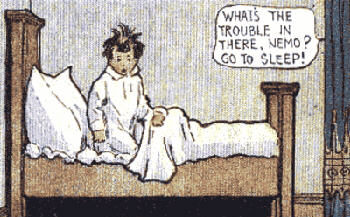 Little NemoIn 1914, McCay's third animated film, Gertie the Dinosaur premiered in his vaudeville act at Chicago's Palace Theater. To animate Gertie McCay drew 10,000 images on rice paper. Each paper was mounted on cardboard and then the images where photographed a frame at a time. Gertie is considered to be the first cartoon with a storyline featuring a star with a personality. Gertie was a dinosaur with emotions that cried and danced and disobeyed. She interacted with McCay's commands and remarks during his vaudeville act. Audiences had never seen anything like it. It's a delightful cartoon and watching it reveals the origins of all the cartoon characters that have followed in Gertie's rather large footsteps. While on a summer vaudeville tour in Detroit in 1916, McCay revealed in an interview that he was working on a film which would show the sinking of the Lusitania. The Sinking of the Lusitania consists of 25,000 drawings produced on transparent celluloid "cels" instead of on rice paper. The "cel" technique allowed McCay to use the same backgrounds with redrawing each scene as had been done in Gertie. While more expensive than rice paper, using "cels" saved time and effort without sacrificing art. Even so, it took twenty-two months to complete and eight days to photograph the short film. As usual, McCay financed the film himself. It would net only $80,000 after years of theatrical distribution. The Sinking of the Lusitania was released on July 20, 1918 by Jewel Productions and was advertised as "the picture that will never have a competitor-will burn in your heart forever! Winsor McCay's Blood Stirring Pen Picture-the World's Only Record of the Crime that Shocked Humanity!" 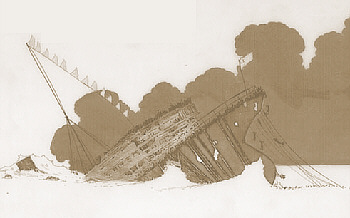 Lusitania Going Under the WavesMcCay's contract with Hearst prevented him from further vaudeville tours and he spent the remaining years producing serious editorial cartoons for Hearst's newspapers. McCay did produce six more films using the "cel" technique. Three survive as fragments: The Centaurs, Flip's Circus and Gertie on Tour. The other three form the Dreams of the Rarebit Fiend series: Bug Vaudeville, The Pet and The Flying House. During World War I, McCay's son Robert and son-in-law Captain Raymond Moniz served in Europe with the 27th Division. Robert McCay was wounded, gassed and suffered from shell shock. He was awarded the British Military Medal and the Distinguished Service Cross. Raymond Moniz was promoted to major for his service with the AEF.
Winsor McCay: The Master Edition is available on DVD from Milestone Film & Video. It includes all of McCay's existing films, the documentary Remembering Winsor McCay by John Canemaker and an extensive stills gallery. Canemaker also provides a very informative audio commentary on McCay's films. Walt Disney Treasures: Behind the Scenes at the Walt Disney Studios was released on DVD in 2002. It includes "The Story of the Animated Drawing" which recreates McCay's vaudeville act with Gertie. Andrew Melomet, Proprietor of Andy's Nickelodeon will answer your Great War film or video inquiry. He is also soliciting your recommendations for the WWI Filmography he is compiling for our readers. Just click HERE. |
| The following are thanked for their contributions to this issue of the Trip Wire:Valerie Varos, Stephen Harris, Christina Holstein, Tony Noyes, Esther MacCallum-Stewart, Nicoll Galbraith, Andy Melomet, Len Shurtleff and the highly informative CIA and Library of Congress Websites. Until next month, your editor, Mike Hanlon. |
| SUBSCRIBE TO THE TRIP-WIRE (Or Send it to a friend.) (Or send us a comment on the TRIP-WIRE) CLICK HERE TO CONTACT US VIA EMAIL | |
For further information on the events of 1914-1918
and membership information visit the Directory Pages of:
|
